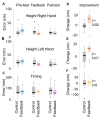Feedback from HTC Vive Sensors Results in Transient Performance Enhancements on a Juggling Task in Virtual Reality
- PMID: 33922711
- PMCID: PMC8123024
- DOI: 10.3390/s21092966
Feedback from HTC Vive Sensors Results in Transient Performance Enhancements on a Juggling Task in Virtual Reality
Abstract
Virtual reality headsets, such as the HTC Vive, can be used to model objects, forces, and interactions between objects with high perceived realism and accuracy. Moreover, they can accurately track movements of the head and the hands. This combination makes it possible to provide subjects with precise quantitative feedback on their performance while they are learning a motor task. Juggling is a challenging motor task that requires precise coordination of both hands. Professional jugglers throw objects so that the arc peaks just above head height, and they time their throws so that the second ball is thrown when the first ball reaches its peak. Here, we examined whether it is possible to learn to juggle in virtual reality and whether the height and the timing of the throws can be improved by providing immediate feedback derived from the motion sensors. Almost all participants became better at juggling in the ~30 min session: the height and timing of their throws improved and they dropped fewer balls. Feedback on height, but not timing, improved performance, albeit only temporarily.
Keywords: HTC Vive; feedback; juggling; learning; timing; virtual reality.
Conflict of interest statement
The authors declare no conflict of interest.
Figures





Similar articles
-
Measurement Accuracy of the HTC VIVE Tracker 3.0 Compared to Vicon System for Generating Valid Positional Feedback in Virtual Reality.Sensors (Basel). 2023 Aug 24;23(17):7371. doi: 10.3390/s23177371. Sensors (Basel). 2023. PMID: 37687827 Free PMC article.
-
Complementary spatial and timing control in rhythmic arm movements.J Neurophysiol. 2019 Apr 1;121(4):1543-1560. doi: 10.1152/jn.00194.2018. Epub 2019 Feb 27. J Neurophysiol. 2019. PMID: 30811263
-
Comparison of Oculus Rift and HTC Vive: Feasibility for Virtual Reality-Based Exploration, Navigation, Exergaming, and Rehabilitation.Games Health J. 2018 Jun;7(3):151-156. doi: 10.1089/g4h.2017.0114. Epub 2018 Jan 2. Games Health J. 2018. PMID: 29293369
-
A quantitative method for evaluation of 6 degree of freedom virtual reality systems.J Biomech. 2019 Dec 3;97:109379. doi: 10.1016/j.jbiomech.2019.109379. Epub 2019 Oct 4. J Biomech. 2019. PMID: 31679757
-
Temporal and spatial factors reflecting performance improvement during learning three-ball cascade juggling.Hum Mov Sci. 2004 Sep;23(2):207-33. doi: 10.1016/j.humov.2004.08.003. Hum Mov Sci. 2004. PMID: 15474178
Cited by
-
A low-cost unity-based virtual training simulator for laparoscopic partial nephrectomy using HTC Vive.PeerJ Comput Sci. 2023 Oct 17;9:e1627. doi: 10.7717/peerj-cs.1627. eCollection 2023. PeerJ Comput Sci. 2023. PMID: 37869468 Free PMC article.
-
A Narrative Review of the Current State of Extended Reality Technology and How it can be Utilised in Sport.Sports Med. 2022 Jul;52(7):1473-1489. doi: 10.1007/s40279-022-01669-0. Epub 2022 Mar 14. Sports Med. 2022. PMID: 35286617 Free PMC article. Review.
-
Application of Virtual and Augmented Reality Technology in Hip Surgery: Systematic Review.J Med Internet Res. 2023 Mar 10;25:e37599. doi: 10.2196/37599. J Med Internet Res. 2023. PMID: 36651587 Free PMC article.
References
MeSH terms
Grants and funding
LinkOut - more resources
Full Text Sources

